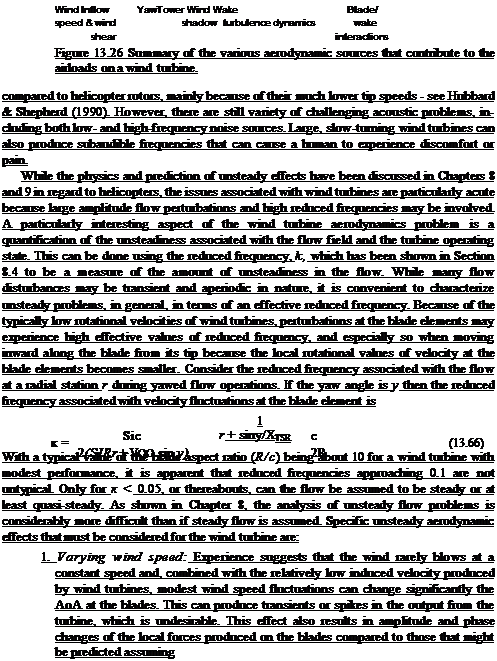Unsteady Aerodynamic Effects on Wind Turbines
It will be apparent from Fig. 13.24 that in the yawed (out of wind) case the component of the wind speed produced in the plane of the turbine produces a Nbtrev unsteady aerodynamic excitation at the blades and so the net power output must fluctuate. Because of the relatively low rotational velocity of wind turbines (about 20 rpm for large turbines and up to 800 rpm for small turbines) and low tip speeds compared to a helicopter, changes in wind speed (or turbulent fluctuations) can result in significant changes in AoA at the blade elements compared to the velocity induced by blade rotation alone. There are also blade flapping effects to consider, assuming that the blades are indeed free to flap about a teetering or gimbaled hub (see Chapter 4). The resulting changes in local AoA and onset velocity contribute significantly to the unsteady flow environment at the blades. While unsteady aerodynamic effects occur under other operating conditions and as a result of other sources, the out of wind (yaw misalignment) performance of the wind turbine is of fundamental importance in wind turbine design.
Wind turbines operate for most of their time in a relatively unsteady flow environment – see Robinson et al. (1995), Huyer et al. (1996), Schreck et al. (2000), and Leishman (2002). Figure 13.26 summarizes the various sources of unsteady airloads on a wind turbine. It is apparent that, like the helicopter, these sources can be decomposed into a variety of essentially periodic and aperiodic contributions. The airloads on each blade element vary in time because of yawed flow, shear in the ambient wind, ambient turbulence, blade flapping and vibratory displacements, and other factors such as “tower shadow” (see Section 13.12.1). Despite the unsteady flow environment, however, wind turbines tend to be relatively quiet
|
|
|
|
 |
![]()
quasi-steady aerodynamics. There is a further lag in the development of the inflow in response to the changing downstream wake structure; such wake adjustments may take place over as many as 10 rotor revolutions.
2. Velocity gradients in the wind: The wind turbine operates in an atmospheric boundary layer with notable velocity gradients – see the schematic in Fig. 13.8. The effects of this gradient can also be seen to some extent in Fig. 13.20 where it is apparent that the lower part of the wake nearer the ground convects more slowly downstream than the upper part. This produces another source of nonuniformity in AoA over the turbine disk, producing a further source of unsteadiness at the blades.
3. Nonsteady velocity fluctuations in yawed flow: Large nonsteady vari ations in the local velocity at the blade elements will be produced whenever the wind turbine is misaligned (yawed) relative to the wind. This is a common occurrence because yaw control mechanisms usually cannot track the wind to sufficient accuracy for perfect alignment to be assured at all times. The low tip speeds of wind turbines means that large excursions from axial flow may occur, which can amplify unsteady effects even though the blade pitch and AoA may be relatively constant. Under these conditions the amplitudes of the excursions involved may often stretch the limits of the unsteady aerodynamic models, which are often derived under the assumption of small perturbations (see Section 8.13.)
4. Nonsteady wake induction effect: Time-varying aerodynamic conditions at the rotor will have an effect on the strength and positions of vorticity shed and trailed into the downstream wake. This evolutionary process has a hereditary effect depending on the prior time-history of the rotor airloads and appears as a temporal lag in the development of the inflow at the rotor disk. This problem has already been discussed in Section 13.11.
5. Local sweep effects: Another source of unsteady effects can be traced to the direction of the incident flow velocities on the rotating blades. Because of the relatively low rotational velocity of wind turbines, the local sweep angle of the flow at any blade element can be very large when the turbine is yawed. With attached flows the independence principle applies and no significant changes in airloads occur. However, the existence of a radial flow component can affect the development of the 3-D boundary layer on the blade and the onset of stall (see Section 13.12.2), leading to somewhat more complicated aerodynamic behavior than would be predicted under nominally 2-D conditions. (See Section 9.7 for further details.)
6. Tower shadow effects: For downwind machines the passage of the blade through the tower wake or “shadow” results in transient changes in AoA on the blade elements. Upstream machines also suffer from the effects of the tower, this effect being similar to the blade passage effect for the helicopter rotor/airframe problem (see Section 11.2.3). This interaction effect may involve effective reduced frequencies that exceed 0.2. The resulting blade loads cannot thus be predicted accurately using quasi-steady assumptions. Such problems also involve steep velocity gradients in the flow. At a modeling level the nonuniformity of the velocity field across the blade chord must be considered carefully. Such effects are modeled fairly well using the unsteady airfoil methods with imposed gust fields (see Section 8.16.3), although downstream wake effects may also have to be considered – see Munduate et al. (2003) and Wang & Coton (2001).
In general, the blade structural loads can be nonsteady because of additional factors, such as periodic variations of gravity forces on the blade in the rotating frame of reference,
transient rotational speed and blade flexibility. To calculate blade loads, coupled nonlinear equations involving rotational, inertial, and unsteady aerodynamic forces need to be solved for prescribed operating conditions. This is a major challenge for the wind energy community and parallels the issues known already for helicopters – see Section 14.11.













